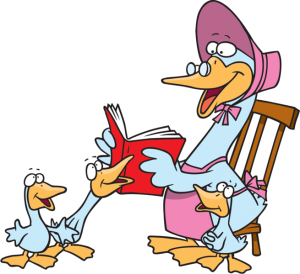 Who isn’t familiar with Jack and Jill tumbling down the hill, or Little Boy Blue falling asleep and letting his animals running amuck, or Little Miss Muffet getting scared by a spider? I remember reading nursery rhymes as a child from a big Mother Goose book that was very old, and is still packed away in the attic somewhere. When my daughters were young, they read from a more modern-looking book with larger print and more colorful illustrations.
Who isn’t familiar with Jack and Jill tumbling down the hill, or Little Boy Blue falling asleep and letting his animals running amuck, or Little Miss Muffet getting scared by a spider? I remember reading nursery rhymes as a child from a big Mother Goose book that was very old, and is still packed away in the attic somewhere. When my daughters were young, they read from a more modern-looking book with larger print and more colorful illustrations.
These stories have been around for hundreds of years, and while fun to chant (I can still recite many of them from memory), they also serve a very important purpose in your young child’s reading development. Read on to find out why these old tales are still so important to share today.
Language Development
Since even the youngest children can learn to sing or speak a rhyme, rhymes offer them the opportunity to verbalize full sentences and complicated vocabulary at an early age. Children learn the basic structures and language patterns of the English language. They also pick up on the rhythm of language and often develop an appreciation of poetry. Children have to hear the language (a lot!) when they are younger in order to, later, understand what they are reading. Nursery rhymes are great for reading out loud due to their rhythmic nature, and gives children exposure to the language and sounds necessary to learn how to read.
Vocabulary Development
Reading or singing nursery rhymes can greatly enhance the size of a child’s vocabulary. A nursery rhyme such as “Twinkle Twinkle Little Star,” for example, contains complex words such as “twinkle” and “wonder.” Children will likely hear words they would not otherwise encounter in everyday conversation. Exposure to new words and concepts greatly increases the likelihood that a child will learn how to read well.
Cognitive Development
How is it I can still recall nursery rhymes so easily after so many years? The musical sing-song and rhythmical nature of them helps with memory and recall of information. Learning and repeating nursery rhymes can also give children practice with the sequencing of events. Many are “mini stories” with clear beginnings, middles, and endings. In addition, a child who has memorized a nursery rhyme could then “read” that rhyme within the context of the book. He or she can practice holding a book, turning the pages in the correct order, and verbalizing in sequence with pictures (even if the words “read” by the child are not the exact words on the page).
If you don’t already have a book of nursery rhymes at home somewhere, it’s time to dig one up or go to the library. Nursery rhymes are fun and funny with colorful characters, and they encourage reading time together. You can recite or sing nursery rhymes with your child at practically any time–in the car, during bath time, in the supermarket–and give him practice with reading fundamentals even when you don’t have access to printed material.
There are also many websites where you can find nursery rhymes. Here are a few online resources to explore:
Rhymes & Fingerplays for Babies, Toddlers, Preschoolers
Enchanted Learning Rebus Rhymes and Rhyme Printouts
Mother Goose Club – Songs, Videos, Printables
Popular Nursery Rhymes from HooplaKidz – YouTube
Do you remember learning nursery rhymes as a kid? Did you have a favorite? Please share with us!


